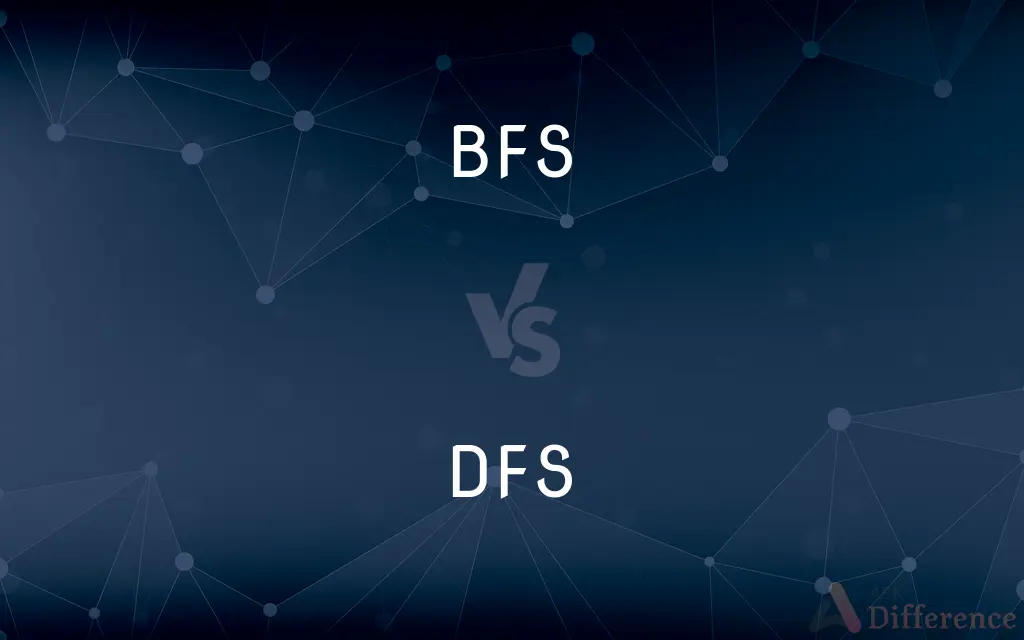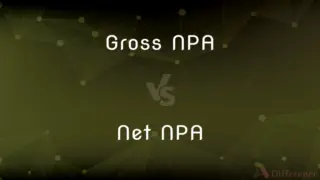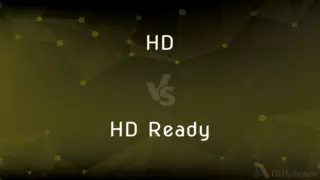BFS vs. DFS — What's the Difference?
Edited by Tayyaba Rehman — By Fiza Rafique — Published on December 13, 2023
BFS (Breadth-First Search) explores nodes level by level in a graph or tree, while DFS (Depth-First Search) explores as far down a branch as possible before backtracking.

Difference Between BFS and DFS
Table of Contents
ADVERTISEMENT
Key Differences
BFS (Breadth-First Search) is a graph traversal method that explores nodes layer by layer, starting from the source node. On the other hand, DFS (Depth-First Search) begins at the root (selecting some arbitrary node as the root in the case of a graph) and traverses as deep as possible along each branch before backtracking.
In terms of implementation, BFS typically uses a queue to keep track of the nodes that need to be explored, processing nodes in the order they were added. Conversely, DFS employs a stack (or can be implemented using recursion), diving deeper into the graph or tree before retreating.
When visualized, BFS appears to expand uniformly, sending out ripples from the starting point, encompassing all accessible nodes of a particular depth before moving deeper. In contrast, DFS dives straight down, exploring a single path in its entirety before returning and trying another.
BFS can be particularly useful in scenarios where the shortest path or minimum number of moves is required, such as in certain puzzle or network routing problems. DFS, meanwhile, excels in scenarios where solutions lie deep within the tree or graph, or when all paths need exhaustive examination.
It's essential to understand that neither BFS nor DFS is universally superior; the choice between them depends on the specific requirements of the task. While BFS might find solutions faster in some contexts, DFS might be more memory-efficient or better suited in others.
ADVERTISEMENT
Comparison Chart
Traversal Method
Level by level
As deep as possible before backtracking
Implementation
Uses a queue
Uses a stack or recursion
Visualization
Expands uniformly from the source
Dives deep down a path before returning
Typical Use Case
Finding shortest paths
Exploring all possible paths
Memory Efficiency
Might use more memory (wide graphs)
Generally more memory-efficient
Compare with Definitions
BFS
Explores nodes in layers, from source outward.
BFS efficiently discovered all nodes at the same depth before moving deeper.
DFS
Suitable for tasks where solutions lie deep within the structure.
To find the hidden treasure, DFS was the preferred method.
BFS
Typically implemented using a queue.
To maintain the order of exploration, BFS uses a queue.
DFS
Can be implemented using recursion or a stack.
The recursive approach made the DFS implementation elegant.
BFS
An algorithm for traversing or searching tree or graph structures.
Using BFS, we found the shortest path between the two nodes.
DFS
Exhaustively examines all paths in its search.
DFS ensured no corner of the labyrinth remained unchecked.
BFS
Useful in finding the shortest path.
For the puzzle game, BFS was employed to find the minimum moves required.
DFS
A technique for traversing trees and graphs by exploring as far down a branch as possible.
DFS explored the deepest cavern first before checking the others.
BFS
Ensures all nodes at current depth are explored first.
BFS made sure all siblings were processed before visiting their descendants.
DFS
Visits a vertex and recursively explores its adjacent vertices.
DFS dived deep into the maze, navigating one path fully before trying another.
BFS
Plural of bf
Common Curiosities
Which is better for finding the shortest path: BFS or DFS?
BFS is typically better for finding the shortest path.
Can DFS be implemented using recursion?
Yes, DFS can be implemented using either recursion or a stack.
How does BFS explore nodes in a graph?
BFS explores nodes level by level, starting from the source node.
Which traversal method uses a queue: BFS or DFS?
BFS uses a queue for its implementation.
Is DFS more memory-efficient than BFS?
Generally, DFS can be more memory-efficient, especially in deep trees.
How does DFS handle dead ends in its traversal?
DFS will backtrack upon reaching a dead end, returning to the previous branch point.
Is DFS always the best choice for deep searches?
Not always. While DFS is suited for deep searches, specific problems might require a different approach or algorithm.
Why might one choose BFS over DFS?
One might choose BFS when looking for the shortest path or when solutions are closer to the source.
Are there graphs where DFS might not visit all nodes?
Yes, in disconnected graphs, a DFS starting from one component might not visit nodes in other components.
What kind of data structure does BFS primarily use?
BFS primarily uses a queue to keep track of nodes to be explored.
Can both BFS and DFS be used on trees and graphs?
Yes, both BFS and DFS can be used for traversing or searching trees and graphs.
Which is typically faster: BFS or DFS?
It depends on the problem. For shortest path problems, BFS might be faster. For exhaustive searches, DFS could be more efficient.
In what scenarios is DFS typically preferred?
DFS is preferred when solutions lie deep within a tree or graph or when all paths need exhaustive exploration.
How does BFS handle nodes at the same depth?
BFS ensures all nodes at the same depth are explored before moving to nodes at the next depth level.
Share Your Discovery

Previous Comparison
Gross NPA vs. Net NPA
Next Comparison
HD vs. HD ReadyAuthor Spotlight
Written by
Fiza RafiqueFiza Rafique is a skilled content writer at AskDifference.com, where she meticulously refines and enhances written pieces. Drawing from her vast editorial expertise, Fiza ensures clarity, accuracy, and precision in every article. Passionate about language, she continually seeks to elevate the quality of content for readers worldwide.
Edited by
Tayyaba RehmanTayyaba Rehman is a distinguished writer, currently serving as a primary contributor to askdifference.com. As a researcher in semantics and etymology, Tayyaba's passion for the complexity of languages and their distinctions has found a perfect home on the platform. Tayyaba delves into the intricacies of language, distinguishing between commonly confused words and phrases, thereby providing clarity for readers worldwide.












































